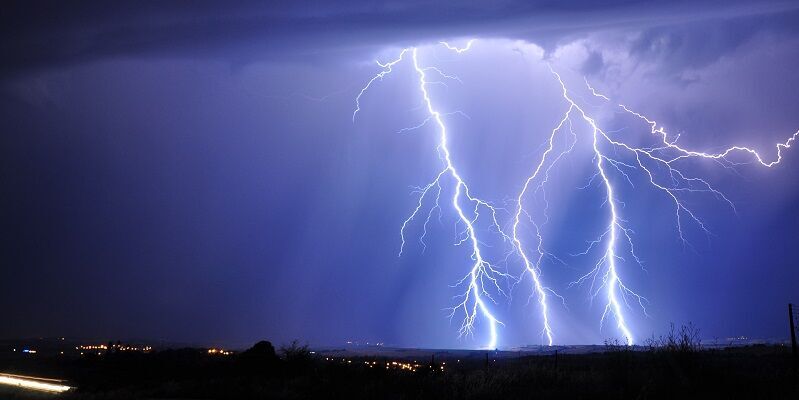防雷中心
防雷中心
日期 一项新的研究表明,全球变暖可能导致雷击减少,影响热带地区的大气成分和天然森林火灾的频率。 包括利兹大学的Declan Finney博士和Alan Blyth教授在内的科学家使用一种新设计的方法预测,如果全球气温继续保持其预测的上升趋势,到2100年,全球平均闪电数量将下降15%。 该研究的主要作者,来自利兹气候与大气科学研究所的Finney博士在爱丁堡大学进行了这项研究。他说:“我们的方法仔细研究了气候变化对导致闪电的基本组成部分的影响。 “预计下个世纪的全球变暖将改变大气温度、湿度和稳定性。这将对冰粒和软冰雹产生重大影响,当它们在雷暴中碰撞时会积聚电荷。正是云层中的这种电荷在暴风雨期间产生了闪电和雷声。 “云冰量的增加或云中上升气流强度的增加导致产生的电荷增加,从而增加闪电的数量。 “该研究中使用的气候变化情景是,到2100年,全球气温将上升约5摄氏度。在这种情况下,云冰颗粒的形成和运动会产生很大影响,导致闪电发生率显着下降。 闪电是一氧化氮的重要来源,一氧化氮是臭氧的前体,会影响甲烷的寿命。低层大气中的臭氧和甲烷都是重要的温室气体,其浓度的变化会导致大气变暖或变冷。 这项研究今天发表在《自然气候变化》杂志上,呼吁在化学气候模型中模拟闪电,以纳入更多闪电产生的基本物理学。从而更好地模拟大气成分与气候变化之间的相互作用和反馈。 芬尼博士说:“了解闪电的未来变化对于预测气溶胶化学的后续变化、雷击引发的自然野火以及闪电对基础设施的破坏非常重要。我们观察到的最大差异是在热带地区,那里发生的闪电最多,是自然野火的主要点火源。 该研究的共同作者、美国国家大气科学中心大气物理学主任艾伦·布莱斯教授说:“显示未来气候中闪电减少的新结果很有趣,不仅挑战了以更基于物理的方式在化学气候模型中表示闪电的方式,而且还挑战了混合相云 - 由过冷云滴和冰晶组成的云。 以前的研究使用云顶高度来预测闪电频率和气候变化的潜在影响。虽然这些方法表明全球变暖可能导致闪电发生率增加,但该研究强调了这种方法的弱点,包括闪电不是由云的高度引起的,而是由冰粒碰撞产生的电荷引起的。 芬尼博士说:“这里的方法将云冰的运动与闪电活动联系起来,与以前用于模拟气候变化的方法相比,它包含了更多控制闪电形成的基本物理学。我们的研究质疑先前闪电预测的可靠性,并鼓励进一步研究气候变化对云冰和闪电的影响。在变暖的星球上不太可能发生闪电风暴

对大气的影响
当前方法的弱点
Lightning storms less likely in a warming planet
Date

Global warming may lead to a drop in lightning strikes, affecting atmospheric composition and the frequency of natural forest fires in the tropics, a new study suggests.
Using a newly-devised method, scientists including Dr Declan Finney and Professor Alan Blyth from the University of Leeds, have forecast a 15 per cent drop in the average number of lightning flashes worldwide by the year 2100, if global temperatures continue on their predicted upward trend.
Study lead author Dr Finney, from the Institute for Climate and Atmospheric Science at Leeds, carried out this research while based at the University of Edinburgh. He said: “Our method looked closely at the impact of climate change on the fundamental components that lead to lightning.
“Global warming over the next century is expected to alter atmospheric temperature, humidity and stability. This would have a significant effect on the ice particles and soft hail which build up electrical charge when they collide in thunderstorms. It’s this charge in clouds that generates the lightning flashes and thunder during storms.
“Increases in the amount of cloud ice or the strength of the updraughts in the clouds leads to an increase in the charge generated and therefore the number of lightning flashes.
“The climate change scenario used in the study was an approximate five degree Celsius rise in global temperatures by 2100. Under this scenario there are large impacts on the formation and movement cloud ice particles, leading to a significant drop in lightning occurrence.”
Lightning is an important source of nitric oxide – which is a precursor of ozone, and which influences the lifetime methane. Both ozone in the lower atmosphere and methane are important greenhouse gases, and changes in their concentrations can lead to warming or cooling effects on the atmosphere.
The study, published today in Nature Climate Change, calls for lightning simulated in chemistry-climate models to incorporate more of the underlying physics of lightning generation. And thereby better simulate the interactions and feedbacks between atmospheric composition and climate change.
Dr Finney said: “Understanding the future changes in lightning is of importance to predicting subsequent changes in aerosol chemistry, natural wild-fires ignited by lightning strikes, and lightning damage to infrastructure. The largest difference we observed was in the tropics, where the most lightning occurs and are the main source of ignition for natural wild-fires.”
Study co-author Professor Alan Blyth, Director of Atmospheric Physics at the National Centre for Atmospheric Science, said: “The new results showing a decrease of lightning in a future climate are interesting and challenge not only the way of representing lightning in chemistry-climate models in a more physically-based way, but also mixed-phase clouds – clouds that are made up of supercooled cloud droplets and ice crystals.”
Previous studies have used cloud-top height to predict lightning frequency and the potential impact of climate change. While these methods have indicated global warming could lead to an increase in lightning occurrences, the study highlights the weaknesses in this approach, including the fact that lightning is not caused by the height of the cloud but by the electrical charge built up through collisions of ice particles.
Dr Finney said: “The method here, which relates the motions of cloud ice to lightning activity, incorporates much more of the fundamental physics governing lightning formation than previous methods applied to simulations of climate change. Our research questions the reliability of previous projections of lightning, and encourages further study into the effects of climate change on cloud ice and lightning.”
上一篇:委内瑞拉的马拉开波湖因闪电浓度最高而被列入吉尼斯世界纪录。
下一篇:气象学家杰夫·哈比(JEFF HABY) 暴风雨在 0.8 平方英里的区域内平均降雨量为 135 英寸